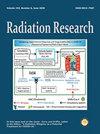Effects of Partial-Body, Continuous/Pulse Irradiation at Dose Rates from Flash to Conventional Rates on The Level of Surviving Blood Lymphocytes: Modeling Approach II. Two- and Multiple-Pulse Irradiation.
IF 2.5
3区 医学
Q2 BIOLOGY
引用次数: 0
Abstract
Mathematical models, which describe effects of partial-body, two- and multiple-pulse irradiation at high total doses D and at average dose rates N from FLASH to conventional rates on the level of surviving blood lymphocytes in humans and mice, have been developed originating in the previously proposed approach. These models predict that levels of surviving blood lymphocytes in humans and mice increase with increasing the dose rate from N = D / TR (TR is the time of the blood flowing into or out of the irradiated segment of the blood circulatory system) to FLASH rates and approach an upper limiting level equal to (1- vR), where vR is the fraction of blood volume in the irradiated segment of the blood circulatory system. Levels of surviving blood lymphocytes computed at total doses D of 10-40 Gy and at average of dose rates N, which are equal to or exceed 40 Gy/s for humans and 400 Gy/s for mice, are nearly indistinguishable from the upper limiting level. These results can be interpreted as the models reproducing the optimal blood lymphocyte sparing in these mammals after such exposures. With decreasing the dose rate from N = D/ TR to conventional rates, at multiple-pulse irradiation the levels of surviving blood lymphocytes in humans and mice decrease to lower limiting levels, whereas at two-pulse irradiation they change cyclically and do not fall below their values for the delivery time equal to TR. Additionally, effects of two- and multiple-pulse irradiation of the whole abdomen in mice on the level of surviving blood lymphocytes are simulated within the developed models. Regimens of two- and multiple-pulse irradiation are taken the same as those reported in experiments, where effects of such exposures on the level of surviving crypts in mice were studied. Juxtaposing the modeling results with the experimental data reveals that the level of surviving blood lymphocytes in mice after two- and multiple-pulse irradiation of the abdomen at average dose rates N from FLASH to conventional rates modulates the level of surviving crypts in these animals after such exposures. A hypothesis is proposed to explain this phenomenon.从闪光到常规剂量率的局部全身连续/脉冲辐照对存活血液淋巴细胞水平的影响:建模方法 II.双脉冲和多脉冲辐照。
数学模型描述了在高总剂量 D 和平均剂量率 N(从闪烁剂量率到常规剂量率)下进行部分体照射、双脉冲照射和多脉冲照射对人类和小鼠血液淋巴细胞存活水平的影响。这些模型预测,随着剂量率从 N = D / TR(TR 是血液流入或流出血液循环系统受辐照区段的时间)到 FLASH 率的增加,人和小鼠血液淋巴细胞的存活水平也会增加,并接近等于(1- vR)的上限水平,其中 vR 是血液循环系统受辐照区段的血液体积分数。在总剂量 D 为 10-40 Gy 和平均剂量率 N(人类等于或超过 40 Gy/s,小鼠等于或超过 400 Gy/s)条件下计算的血液淋巴细胞存活水平与上限水平几乎没有区别。这些结果可以解释为模型再现了这些哺乳动物在受到这种照射后的最佳血液淋巴细胞疏通情况。随着剂量率从 N = D/ TR 到常规剂量率的降低,在多脉冲辐照下,人和小鼠血液淋巴细胞的存活水平会降低到较低的极限水平,而在双脉冲辐照下,它们会发生周期性变化,并且在辐照时间等于 TR 时不会低于其值。此外,在开发的模型中还模拟了对小鼠整个腹部进行双脉冲和多脉冲辐照对存活血液淋巴细胞水平的影响。双脉冲和多脉冲辐照的方案与实验报告的方案相同,在实验中研究了这种辐照对小鼠体内存活隐窝水平的影响。将建模结果与实验数据并列显示,小鼠在腹部接受双脉冲和多脉冲辐照(平均剂量率 N 从 FLASH 到常规剂量率)后,其血液淋巴细胞的存活水平会调节这些动物在这种辐照后的隐窝存活水平。为解释这一现象提出了一个假设。
本文章由计算机程序翻译,如有差异,请以英文原文为准。
求助全文
约1分钟内获得全文
求助全文
来源期刊

Radiation research
医学-核医学
CiteScore
5.10
自引率
8.80%
发文量
179
审稿时长
1 months
期刊介绍:
Radiation Research publishes original articles dealing with radiation effects and related subjects in the areas of physics, chemistry, biology
and medicine, including epidemiology and translational research. The term radiation is used in its broadest sense and includes specifically
ionizing radiation and ultraviolet, visible and infrared light as well as microwaves, ultrasound and heat. Effects may be physical, chemical or
biological. Related subjects include (but are not limited to) dosimetry methods and instrumentation, isotope techniques and studies with
chemical agents contributing to the understanding of radiation effects.
 求助内容:
求助内容: 应助结果提醒方式:
应助结果提醒方式:


